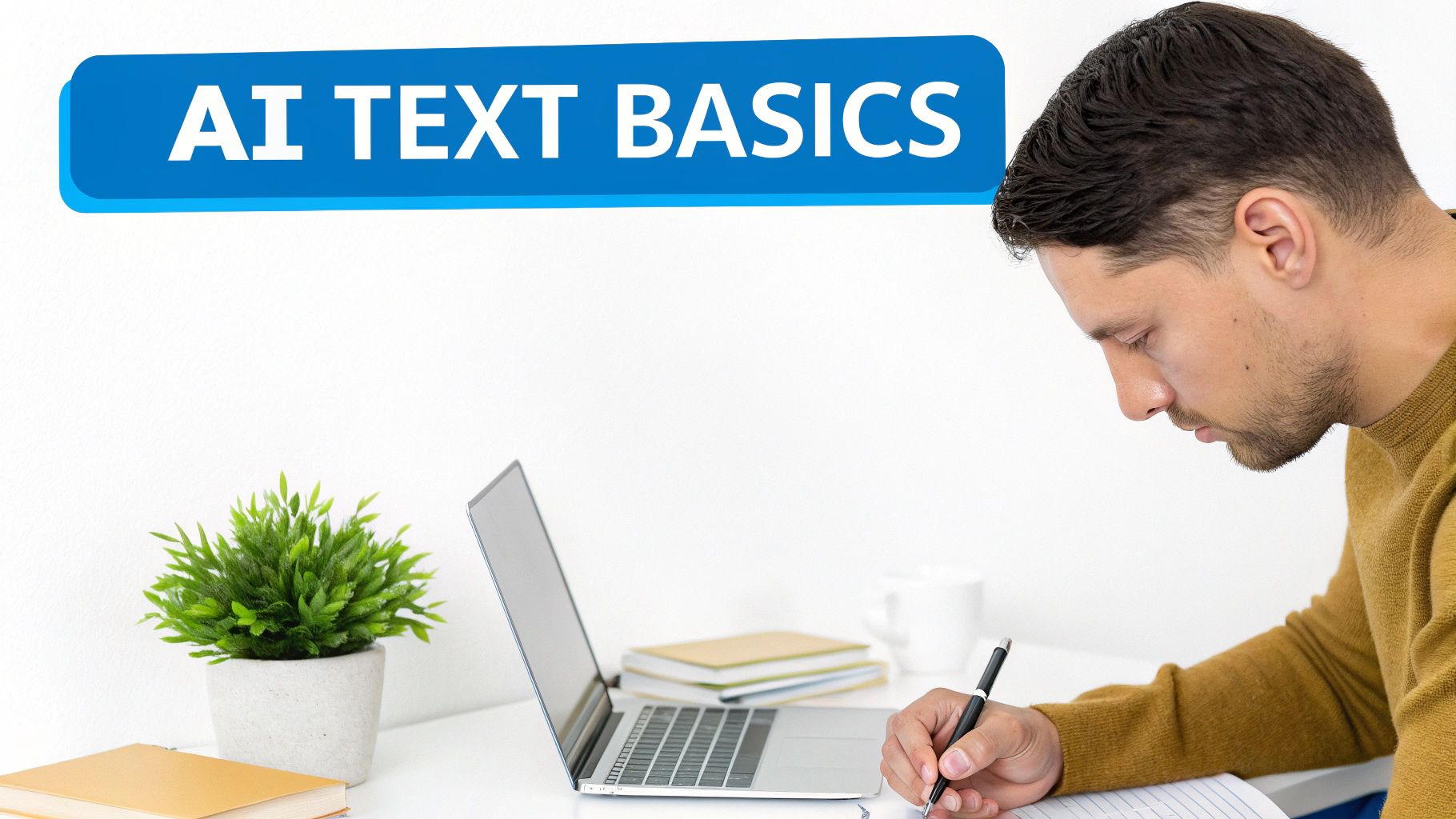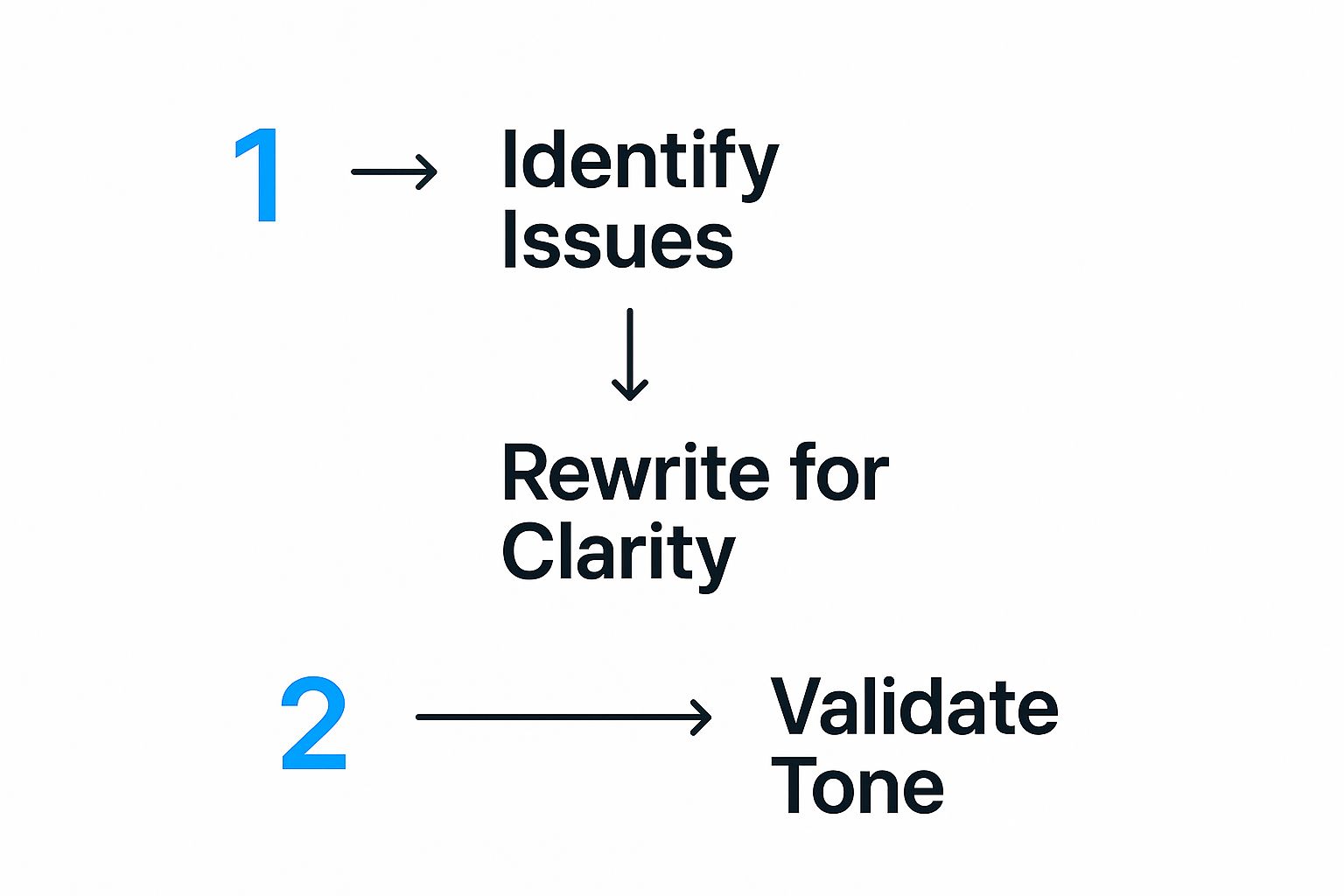Master How to Rewrite AI Generated Text Effectively

Think of your first AI-produced draft as a lump of clay. It’s got the basic shape and substance, but it’s far from a finished sculpture. While AI is brilliant at churning out content quickly, it often lacks the soul, the nuance, and the genuine connection that only a human can bring to the table. The real magic happens when you step in to change that functional, often generic, text into something that truly speaks to your audience.
Why AI-Generated Text Needs a Human Touch
Let's be real for a second. Raw output from an AI can feel… well, robotic. It's a fantastic way to get past the blank page, but it almost always misses the special point of view that makes writing truly compelling. Your goal isn’t just to clean up mistakes; it's to inject your brand's voice and personality to build a real relationship with your readers.
This whole process is about adding a layer of depth and authenticity that machines just can't copy on their own. An AI probably won't get the inside jokes your audience loves or understand the specific frustrations they deal with every day. It's your job as the writer to bridge that gap.
Common Signs of Machine-Written Text
You can usually spot machine-written content from a mile away once you know what to look for. It might sound a little too formal or use the same sentence structure over and over again.
Here are a few other dead giveaways:
- A Generic or Neutral Tone: The text is flat. It has no distinct personality or emotional hook to pull you in.
- Repetitive Phrasing: You'll see certain words or phrases pop up way too often, making the whole piece feel monotonous.
- Lack of Personal Stories: The writing is all facts and no flavor. It’s missing the anecdotes and real-world examples that make content relatable.
- Overly Complex Sentences: Sometimes, AI spits out long, convoluted sentences that a human would instinctively break down.
Spotting these signs is the first step toward turning that robotic text into something brilliant.
To give you a clearer picture, let's break down the differences.
AI Content vs Human-Rewritten Content at a Glance
This table offers a quick comparison, showing the key differences between a standard AI draft and a piece that's been polished by a human hand.
| Characteristic | Typical AI-Produced Text | Human-Rewritten Text |
|---|---|---|
| Tone of Voice | Often generic, neutral, or overly formal. | Distinct, authentic, and in line with brand voice. |
| Sentence Structure | Can be repetitive and lack variety. | Varied, with a natural mix of short and long sentences. |
| Emotional Connection | Lacks genuine emotion and personal touch. | Includes stories, empathy, and relatable examples. |
| Flow and Readability | May sound clunky or use awkward phrasing. | Smooth, conversational, and easy to read. |
| Originality | Tends to state facts without special insights. | Infused with personal expertise and fresh perspectives. |
As you can see, the human element is what lifts content from merely functional to truly compelling.
Building Trust Through Authenticity
By 2025, AI-powered rewriting tools became a cornerstone of content creation, helping writers improve both their speed and the quality of their work. These tools can rephrase entire articles in a matter of seconds while keeping the original meaning, completely changing how we approach content refreshes.
Even with these incredible tools at our fingertips, your audience is still hungry for authenticity. Content builds trust when it feels genuine and comes from a place of real, lived experience. A machine can't share a personal failure or a lesson learned the hard way. But you can.
This is your biggest advantage in a world saturated with AI content. As AI's role in content continues to grow, staying on top of the latest influencer marketing trends, including AI integration is crucial. In the end, it’s your unique point of view that makes your content stand out and keeps people coming back for more.
Laying the Groundwork: Essential Manual Rewriting Techniques
Before you even touch a tool, you need to get your hands dirty with the text itself. Building your manual editing skills is what truly separates decent content from stuff that actually connects with people. This is where you bring in the human judgment and creativity a machine just can’t copy, turning a bland AI draft into something worth reading.
One of the first things I always tackle is the rhythm of the text. AI-produced sentences often have this weird, uniform feel—all the same length, all the same structure. It’s boring. Your job is to break up that monotony. Mix short, punchy sentences with longer, more descriptive ones. It should feel like a real conversation, not a robot reading a script.
Swap Out Weak Words for Stronger Ones
A dead giveaway of AI writing is its love for generic, vanilla vocabulary. You’ll see words like "good," "helpful," or "many" all over the place. An AI might say something is "good" when it could have been "brilliant," "effective," or "rock-solid." You need to be a wordsmith, hunting down these weak links and swapping them for powerful, specific language that paints a vivid picture.
For instance, an AI might spit out:
- "The product has many helpful features."
A human editor would instantly see the opportunity to add value and change it to:
- "The product's intuitive dashboard and one-click reporting save users hours each week."
See the difference? That small change moves from just telling the reader something is good to actually showing them why it's valuable. It’s way more convincing.
A great manual rewrite isn’t about changing every single word. It's about finding those few key places where a better word or a different sentence structure makes the biggest impact on the writing's feel and engagement.
Weave in Your Own Voice and Stories
This is where you really make the content yours. An AI has no personal experiences, no brand stories, and no special industry takes. Weaving these human elements into the text is, hands down, the best way to build credibility and connect with your audience.
Look for places to sprinkle in:
- Personal Anecdotes: A quick story about a time you succeeded (or failed!) can make a point far better than a dry, theoretical explanation.
- Brand-Specific Examples: Reference your own products, team members, or company events. This makes the content uniquely yours and impossible to copy.
- Real Opinions: AI is programmed to be neutral. Don’t be. A strong, well-reasoned opinion makes your content stand out and gets people talking.
Simplify and Clarify the Message
Sometimes, AI tries too hard to sound smart, cranking out ridiculously complex or tangled sentences. It thinks it sounds authoritative, but it usually just ends up confusing the reader. Your job is to be the voice of clarity.
Chop up those long, winding sentences. Define any jargon. Rephrase confusing passages until they’re dead simple to understand. The final goal is to make the information as easy as possible for your audience to digest.
Mastering these manual techniques gives you a solid foundation. You’ll learn to spot the tell-tale signs of a raw AI draft and know exactly what it needs to shine. This hands-on experience doesn't just make you a better editor—it helps you get far more out of any rewriting tool you decide to use down the line.
Using Tools to Polish Your Writing
While manual editing is always going to be part of the process, the right tools can make the job a whole lot smoother. Think of them as a skilled assistant, not a replacement for your own judgment. They handle the tedious work of sentence structure and word choice, which frees you up to focus on the big-picture stuff—like the story, the flow, and the overall message.
We're not talking about those old-school article spinners that just spit out gibberish. Today's tools are built for improvement, helping you rewrite ai generated text until it sounds genuinely human and interesting. They're designed to help you move past just fixing awkward phrases and start truly polishing your content.
For this kind of deep-dive editing, many people turn to Word Spinner. It's a leading choice for taking robotic, clunky text and changing it into something with a real human feel. Its advanced rewriting capabilities help remove patterns that AI checkers easily flag, helping you create original, plagiarism-free content with a natural tone every time.
From Robotic Draft to Polished Final Copy
Let's walk through a situation you've probably encountered. You've got a piece of AI-produced text for a product description. All the facts are there, but it's completely lifeless.
- Initial AI Draft: "Our new software is a robust solution designed to optimize your workflow. It has many features that make it a good choice for businesses looking to increase their efficiency."
This is classic AI-speak. It's dry, generic, and completely forgettable. It tells you what the software does, but it doesn't make you feel anything about it. This is the perfect starting point to run through a quality rewriting tool.
Reviewing and Improving the Output
Once the tool provides a new version, it’s your turn to step back in. Your job is to put on your editor's hat and check for improvements in a few key areas:
- Tone: Does the rewritten text actually sound like your brand? Is it more conversational, more professional, or maybe more energetic?
- Word Choice: Have weak, overused words been swapped out for more powerful, descriptive language?
- Readability: Is the text simply easier to read? Look for a nice mix of short and long sentences that create a better rhythm.
A good rewriting tool will give you options that immediately sound more natural. For instance, it might take that dull software description and suggest something like this:
"Ready to simplify your workday? Our new software helps your team get more done with less effort. Its clever tools are built to make your daily tasks feel surprisingly easy."
See the difference? This version is way more appealing. It opens with a question, uses simpler language ("clever tools" instead of "robust solution"), and speaks directly to what the reader actually wants. The core message is identical, but the delivery is worlds better.
This whole process is a cooperation between you and the tool—it's about smart assistance, not a hands-off approach.
AI rewriting tools are becoming standard practice in a lot of fields. Take e-commerce, for example, where businesses use them to rewrite thousands of product descriptions at once—a task that would have been a massive manual effort just a few years ago. You can find more examples of how AI is helping businesses at scale on platforms like numerous.ai. It really shows how these tools are helping people tackle huge writing jobs much more efficiently.
My Practical Workflow for Humanizing AI Text
Having the right skills and a great tool is one thing, but merging them into a repeatable process is what really saves time and keeps your content quality consistently high. This workflow is my simple, go-to method to rewrite ai generated text, taking you from that initial robotic draft to a polished, human-sounding final piece.
Think of it as your game plan. This structured approach takes the guesswork out of the equation and makes sure you hit all the crucial improvement steps, every single time. It's all about working smarter, not harder, to get the results you need.
This visual guide breaks down the core steps I follow for an effective rewrite.
As you can see, the process isn’t just a single action. It’s a sequence of identifying, rewriting, and checking to lock in that natural, human tone.
First Pass: The Initial Read-Through
Before you touch a single word, read the entire AI draft from start to finish. Don't stop to edit. Your only goal here is to understand the core message. What's the main point? What are the key supporting arguments or pieces of information?
This first pass gives you a bird's-eye view of the content. It helps you grasp the overall structure and quickly spot whether the AI even understood the prompt correctly. You're not looking for typos yet; you're just checking for substance.
Second Pass: Identify and Mark Problem Areas
Alright, now go back to the beginning. Read it again, but this time with a critical eye. This is your "search and destroy" mission for all the awkward, robotic, or just plain clunky parts of the text.
I usually highlight or make notes on:
- Repetitive Words and Phrases: Did the AI use "in conclusion" three times? I mark every instance.
- Awkward Phrasing: If a sentence just sounds weird when you read it, highlight it. Trust your gut.
- Overly Formal Language: Keep an eye out for unnecessarily complex words or stiff, academic sentence structures.
- Generic Statements: Find any claims that lack specificity or real-world examples. These are prime opportunities to add value.
This step essentially creates a roadmap for your manual rewrite, showing you exactly where your human touch is needed most.
Remember, the goal isn't to rewrite everything. It's to surgically improve the parts that feel the most machine-like, preserving the solid foundation the AI provided.
Third Pass: The Manual Rewrite and Voice Injection
This is where the real change happens. Go through your marked-up document and start making changes. This isn't just about swapping words; it's about infusing your unique voice and point of view into the text. You can find some great pointers for this in our detailed guide on how to humanize AI content.
During this stage, I focus on a few key actions:
- Rephrase awkward sentences so they flow more naturally.
- Add personal stories or anecdotes to make the content more relatable.
- Incorporate my brand’s specific terminology or viewpoint.
- Simplify complex ideas to make them easier for the audience to digest.
This is exactly the kind of side-by-side editing that makes the process so much faster.
Having a simple layout like this makes it easy to compare the original and rewritten text, helping you make quick, effective edits without losing your place.
Final Pass: The Polish and Originality Check
Last step. Read the entire piece one final time, and I strongly recommend reading it aloud. This is the best test for natural flow and a conversational tone. If you stumble over a sentence, your reader probably will too.
This is also the moment to double-check for originality. Your final piece should be 100% unique and completely free of any plagiarism. This structured workflow, combining careful manual editing with smart tool assistance, gives you a dependable method for turning any AI draft into a high-quality piece of content you can be proud to publish.
Common Questions About Rewriting AI Text
As you start turning AI drafts into polished copy, a few questions always seem to come up. Let's tackle some of the most common challenges people face when learning to rewrite AI generated text so it feels genuinely human.
How Can I Make AI Text Sound Less Formal?
Getting AI-produced text to sound more casual is all about loosening it up. Start with the basics: swap out stuffy, complex words for simpler, everyday language. Don't shy away from contractions like "it's," "you'll," or "can't"—they're a dead giveaway of natural conversation.
Another quick win is to break up those long, winding sentences AI loves to write. Shorter, punchier sentences make a world of difference.
Here’s a great pro tip: read the text out loud. If it sounds robotic or like something you'd never actually say, you know it needs work. Try weaving in a personal story, a quick example, or even asking the reader a direct question. That immediately makes the tone friendlier and far more interesting.
Will Rewriting AI Text Help Me Avoid Plagiarism?
Absolutely. Rewriting isn't just a suggestion; it's a critical step for making sure your work is original. Raw AI output can sometimes hug its source material a little too closely, and that can get you into trouble.
When you take the time to really rework the text—changing sentence structures, swapping in new words, and injecting your own special point of view—you're creating something entirely new. That's what puts distance between your final piece and the initial AI draft. Using a dependable tool designed to check for originality is also a smart final step to make sure your content is clean before you publish.
Can Search Engines Find and Penalize AI Content?
Here's the thing: search engines care about quality and usefulness, not how the content was born. The real issue isn't using AI—it's publishing lazy, spammy content that offers zero value to the reader. An unedited AI draft that's generic and unhelpful is never going to rank well, simple as that.
By taking the time to rewrite AI-produced text, you add the originality, expertise, and human touch that search engines are designed to reward. This focus on quality is what helps you create content that ranks well and avoids any potential issues.
If you're dealing with academic work, knowing how to present your research is another important layer. We cover that in more detail in our guide on how to present an AI-generated essay.
Ready to change your AI drafts into polished, human-sounding content? Word Spinner is a leading tool with advanced rewriting capabilities to humanize your text, remove AI writing patterns, and produce 100% plagiarism-free material. Try it free today at https://word-spinner.com.


